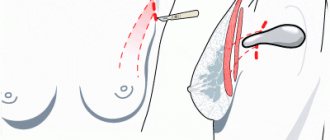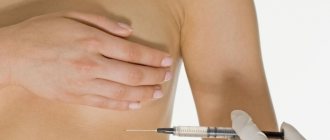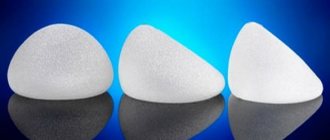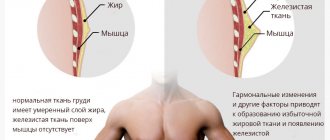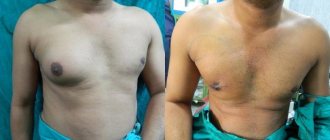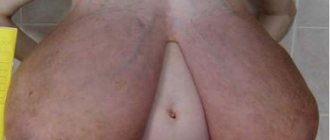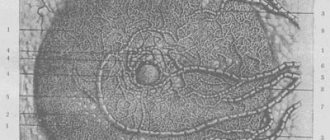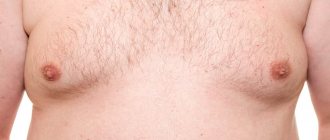from 320,000 rub.
Cost of the operation
If a woman is not satisfied with the natural volume or shape of the mammary glands, endoprosthetics - breast surgery using implants - will help correct the situation. Augmentation mammoplasty enjoys well-deserved popularity among women of all ages, allowing to eliminate such disadvantages as:
- underdevelopment (lack of volume) of the mammary glands,
- pronounced asymmetry of the mammary glands,
- lack of breast volume due to loss of skin tone (usually after childbirth and breastfeeding),
- absence of mammary glands (usually associated with the removal of tumors due to breast cancer).
A breast augmentation implant is placed in a “pocket” formed from tissue under the pectoral muscle or directly under the gland. Implant placement can also be done through several types of access. The main (most common) are:
- submammary,
- transareolar,
- transaxillary.
Of course, each access has its own specific features and its own scope of application.
Submammary access
The incision in this case is no more than 5 centimeters long and is located in the natural fold under the breast (submammary fold). Submammary access allows you to perfectly accurately form a symmetrical “pocket” for placing an endoprosthesis. The breast tissue is not affected; there are no restrictions on the use of round or anatomically shaped implants with this type of access. The implant can be freely installed both under the muscle and under the gland.
In total, the main advantages of this access:
- simple, versatile and safe,
- allows the surgeon to gain full control of the position of the endoprosthesis.
The disadvantage of this method is that in patients with an insufficiently pronounced inframammary fold, the postoperative scar may be very noticeable.
Correction methods
Surgery to eliminate double breast folds requires general anesthesia. Access to the prosthesis is made at the site of the previous incision. The scale of the manipulations performed varies greatly and is determined by the reasons for the defect being corrected:
- Capsulorrhaphy.
If the implant has been displaced, then as part of the re-intervention, the boundaries of the pocket are changed by performing capsulorrhaphy - it expands, and the endoprosthesis is moved into this area. In some cases, additional dissection may be required. This operation is performed both with and without breast implant replacement. - Reendoprosthetics.
To avoid thinning of the implant cover, some surgeons resort to pre-strengthening it with alloderm. If this was not done during the primary breast surgery, one of the possible options is subpectoral endoprosthetics. - Breast lipofilling.
In some cases, the problem is solved by performing lipofilling, when the deficit in adipose tissue volume is compensated by introducing autologous fat grafts. The procedure involves preliminary collection of biomaterial from the inner surface of the thigh, back or abdominal area directly from the patient herself. After this, purification in a centrifuge and subsequent injection of fat cells into the recipient area.
Regardless of the techniques used, repeated mammoplasty is aimed at giving the mammary glands an aesthetic appearance, creating symmetrical submammary folds, eliminating waves and other defects. If necessary, the intervention can be supplemented with one-stage mastopexy.
Transareolar access
An incision made in the area of the areola (around the nipple) allows for a completely invisible post-operative scar. It is permissible to install round or teardrop-shaped implants under the gland or under the pectoral muscle. A significant drawback of the method is that during penetration, the breast tissue is dissected, and subsequent damage can provoke lactation disorders (up to the impossibility of breastfeeding). A limitation to the use of this method is the size of the areolas: if the patient has miniature areolas, the surgeon will not be able to make an incision around the nipple long enough to install the prosthesis.
Access for breast augmentation
Not all women are satisfied with the shape and size of the bust given by nature. Breast plastic surgery has remained a relevant solution to this issue for many years. Qualified specialists in the field of breast plastic surgery offer a wide range of breast augmentation services.
The operation is performed with one of four types of access, selected taking into account the individual characteristics of the patient:
- submammary
- transumbilical
- axillary
- periareolar
Access under the chest
Submammary access is the very first type, which has been successfully used for a long time. An incision is made in the area of the submammary fold exactly along its borders. After an incision in the skin, the breast tissue is pulled apart and an implant of the required size is inserted inside it.
Advantages:
- There is no risk of damage to the mammary glands.
- The implant can be installed in two ways: under the pectoral muscle or under the mammary gland. The first option is considered more optimal, since the implant is installed deeply and cannot be felt, which allows you to achieve the maximum natural effect.
- There are no restrictions on shape and size - the choice is made taking into account the wishes of the patient.
- The postoperative scar in the presence of a fold under the breast remains invisible.
Flaws:
- Long rehabilitation period.
- The scar from the suture is quite obvious if the incision under the breast was not made carefully enough.
- The suture will be noticeable if the patient does not have a submammary fold due to small breast size.
Navel access
At the moment, transumbilical access is officially prohibited based on the legislation of the Russian Federation. It differs in that the postoperative scar is as invisible as possible due to the distance from the surgical site. This operation was carried out through an incision in the navel, into which an empty implant was inserted, and upon reaching the required location, it was filled with saline solution.
Advantages:
- The scar is located far from the surgical site.
- Minimal invasiveness, as the implant is inserted through punctures.
- Relative safety - leakage of saline solution into the mammary gland does not threaten the development of pathological processes.
Flaws:
- The passage of the implant to its destination may cause damage to the circulatory system.
- Fragility due to the unreliability of the implant.
- Mandatory repeated surgical interventions due to the short shelf life of implants of this type.
Access through the armpit
In medical terminology, implantation through the armpit is called axillary or endoscopic access. During breast surgery, a small incision is made into which, among other instruments, an endoscope is inserted to monitor the progress of the operation.
Thus, all blood vessels and lymph nodes on the way to the operated mammary gland are visible. Therefore, the risk of damage is minimal. This method is a good option for women with small breasts.
Advantages:
- Short rehabilitation period due to low invasiveness.
- Placement of the implant is allowed not only under the mammary gland, but also under the pectoral muscle.
- There is no visible postoperative scar, as it is located in the armpit.
Flaws:
- There are restrictions on the volume of the implant - no more than the fourth size.
- Painful sensations after surgery due to the distance of the access site from the mammary glands.
- There are a small number of qualified surgeons capable of performing such an operation.
Nipple access
The periareolar approach is distinguished by making an incision in the area of the areola, or more precisely, at the border of the areola and the skin of the breast.
Advantages:
- The presence of a barely noticeable scar from the seam, located out of the reach of prying eyes.
- The implant can be placed under the mammary gland or under the pectoral muscle.
- The size and shape of the implants do not matter.
Flaws:
- Dissection of the mammary glands, which can lead to injury.
- There is a risk of loss of sensitivity of the nipple-areola complex.
- A noticeable seam if the cut was not made carefully enough.
With the development of plastic surgery, it became possible to perform a sutureless operation through the periareolar approach. An incision is also made at the border of the areola and the skin of the breast, the tissues are moved apart, which makes it possible to make a passage channel. An implant is installed through it and then a subcutaneous suture is applied. The skin in the area of the incision is connected using medical glue. Subsequently, special fixing strips are glued to the same place.
Advantages:
- There is absolutely no bleeding during the operation.
- Maximum invisible seam due to the use of medical glue.
- Gentle mode of surgical intervention.
- The implant can be inserted under the pectoral muscle or under the mammary gland, depending on the wishes of the patient.
Flaws:
- Limited implant size due to lack of sutures.
- The method is used only in the areola area.
A scar after such an operation will still remain, but it will be least noticeable.
Transaxillary access (endoscopic technique)
This access is located in a natural fold in the armpit area and allows you to completely hide the fact of the intervention (the incision quickly becomes invisible).
It is also important that the breast tissue is not affected. Transaxillary access allows you to install implants of any shape in any way.
The main disadvantage of the transaxillary approach is the complexity of execution. Despite this, this option remains preferable.
Anton Igorevich Zakharov performs various plastic surgeries in Moscow, and over the years of practice he has acquired vast experience in this field. Endoscopic breast augmentation (enlargement with transaxillary access) is one of the main specializations of Dr. Zakharov
Explantation
Few women choose explantation without replacing the endoprosthesis in order to eliminate a double fold on the breast; this is not an easy decision. However, if it was accepted by the patient, the surgeon is tasked with giving the mammary gland an aesthetic shape. In this case, it is often required to be tightened, since many years of “wearing” implants leads to the formation of ptosis against the background of stretching of the integumentary cover. In case of severe breast ptosis and the need to transfer the nipple-areolar complex by 4 cm or more, the operation is performed in two stages - first, the breast implants are removed, then (after 3 months) mastopexy is performed.
A little theory
Everyone has small nasolabial folds - it's a fact! But it’s one thing when they appear from a smile or laughter - at that moment we are so beautiful that no wrinkles can spoil our beauty! And it’s quite another thing when the insidious nasolabials begin to feel like full-fledged mistresses and confidently restore their order to our faces. Then, instead of beautiful and cheerful us, someone is reflected in the mirror, someone who is always gloomy and tired.
Forbidding yourself to smile is not an option at all. There are too many good moments in life that deserve laughter, and a smile is too beautiful to lose it! What to do? Relax tissues and restore muscle tone!
What to do
First, deal with the obvious problems (if any): visit the orthodontist, adjust your skin care, adjust your regimen. And then move on to action. I note that some defects in the middle part of the face are secondary: they are only a consequence of age-related changes in posture, neck muscles and soft tissues of the face. Therefore, nasolabial folds can be significantly reduced with facial exercises.
It is this approach that helps restore youth without injections, surgical scalpels and aggressive cosmetology. But you need to understand that if you want to achieve a lasting effect, you need to eliminate the root cause (restoring posture, correct neck statics, relaxing tense muscles, etc.).
Source: https://www.yapokupayu.ru/blogs/post/nosogubnye-skladki-kogda-oni-norma-a-kogda-povod-dlya-bespokoystva-rasskazyvaet-ekspert
Why do they go deeper
There are many reasons. These include heredity, malocclusion, features of facial anatomy, and too dry skin. In many cases, our habits and actions lead to the deepening of nasolabial wrinkles: incorrect posture, excessive weight gain or loss, stress and lack of sleep, improper skin care, insufficient ultraviolet protection and others.
For example, with low pressure, tissues can hang sluggishly due to the lack of adequate blood supply and a decrease in turgor (elasticity), and with structural features of the face - a short upper jaw from birth - soft tissues cannot take an anatomically correct position and “fall” down. But even in such cases, with the help of Revitonics you can significantly reduce creases and wrinkles. It is also worth mentioning the nasolabial ridges - defects that form a kind of lymph pocket in which excess fluid accumulates. This change develops due to muscle hypertonicity.
